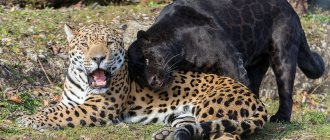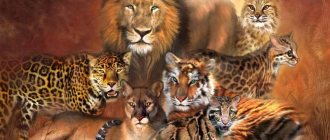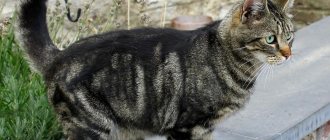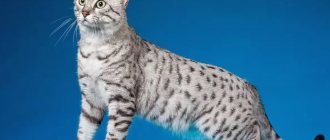On the first day of spring, March 1, Cat Day is celebrated in Russia. According to some reports, the holiday was first organized in 2004 by the Moscow Cat Museum and the newspaper “Cat and Dog”. Interestingly, many countries also have national days to honor these animals. For example, in the USA it is October 29, in Poland – February 17, in Japan – February 22. And the basis for all national Cat Days was World Cat Day, celebrated on August 8th.
The cat family belongs to the class of mammals, the order of carnivores. All cats - from the small domestic cat to the large Amur tiger - are excellent hunters. The first cat-like mammals appeared about 60 million years ago, during the Eocene era. The evolution of true cats began about 40 million years ago. Modern felines are divided by genera into cheetahs, caracals, catopumas, tiger cats, servals, lynxes, marbled cats, Asian cats, golden cats, pumas, clouded leopards, panthers and just cats, which also includes the domestic cat, a subspecies of the forest cat. The fauna of Russia includes such felines as the Far Eastern forest cat, manul, jungle cat, forest cat, common lynx, Amur tiger, Far Eastern and Central Asian leopards, snow leopard and caracal.
The Russian Geographical Society is engaged in the conservation and study of rare feline species: the Amur tiger, the Far Eastern leopard, the snow leopard, the manul and the lynx.
Amur tiger
The Amur tiger is one of the largest land predators on our planet: the body length of males reaches 220 cm, weight - 185 kg. It is also one of the smallest subspecies of tiger - about 550 individuals live in the wild. 95% of the entire population lives in the Russian Far East and 5% in China. In Russia, the Amur tiger population is concentrated in the Primorsky and Khabarovsk Territories, the Amur Region and the Jewish Autonomous Region. 20% of the Russian habitat is in nature reserves, national parks and sanctuaries - a special protection regime has been established here and animals can feel safe. The remaining 80% are hunting grounds, where the Amur tiger has to compete with hunters for ungulates. The Amur tiger is listed in the Red Book of the International Union for Conservation of Nature (IUCN) and in the Red Book of the Russian Federation.
svetlana-sutyrina-amurskiy-tigr-2.jpg
Amur tiger. Photo: Svetlana Sutyrina
Interesting Facts
- The Amur tiger lives in low mountains, preferring river valleys and wide valleys between ridges, covered with forest.
- The tiger is omnivorous. He can eat both a frog and a bear. However, in the wild, Amur tigers prefer to feed on ungulates: deer, wild boar, roe deer and musk deer. For adequate nutrition, one tiger needs about 50–70 ungulates per year. At the same time, a tiger can eat up to 35 kg of meat in one go.
- A tiger can jump 5 m upward and 10 m long.
- A tiger's tail is a kind of indicator of its mood. When the tiger is calm, the base of its tail is lowered and the end is curved smoothly upward.
- The span of a tiger's whiskers roughly corresponds to the width of its body. Thanks to its whiskers, the predator is able to determine the nature of the surface, temperature, and wind direction. The animal is guided by its whiskers when moving in the dark.
Since 2010, the Russian Geographical Society has supported the Amur Tiger project. Its goal is to study the state of the Amur tiger population and develop scientific foundations for the conservation of the animal. In 2013, on the initiative of the President of the Russian Federation, Chairman of the Board of Trustees of the Russian Geographical Society, Vladimir Putin, the Society became the founder of an autonomous non-profit organization. Its activities focus on the fight against poaching, scientific analysis of the state of the Amur tiger population and ecosystems in the animal’s range, and the organization of educational and educational events.
Far Eastern leopard
The Far Eastern leopard is the rarest subspecies of the cat family on Earth. Currently on the verge of complete extinction. According to various estimates, about 80 individuals live in natural conditions. At the same time, most of the population lives in Russia in the Primorsky Territory and a smaller part lives in China. About 70% of the rare predator's habitat is protected by the Land of the Leopard National Park. In the 20th century, the species was listed in the IUCN Red Book, the Russian Red Book, the IUCN Red List and in Appendix I to the Convention on International Trade in Endangered Species of Wild Fauna and Flora (CITES).
History of the species
Scientists believe that the Forest Cat appeared in the Pleistocene era, which began more than 2.5 billion years ago and ended 11.7 million years ago. Considering that humanity is only 2.8 billion years old, wild cats are at least 9 years older than humans.
The end of the Pleistocene era is characterized by an incredibly harsh climate. The planet had just experienced an ice age, the ice masses were retreating reluctantly, weather conditions also changed in waves - periods of sharp warming alternated with periods of the onset of very cold air masses. These processes served as an impetus for the transformation of flora and fauna. It was at this time that the woolly rhinoceros, mammoth, giant deer, cave lion and many other species appeared, most fully adapted to harsh climatic conditions.
With subsequent global warming, most animals of the glacial and post-glacial periods were unable to mutate and became extinct. The cat, which went into the shady forests and mountain ranges, managed to survive.
Thus, we can only talk about the approximate, latest date of the emergence of the European forest cat as a species - 11.7 million years ago. Although, most likely, this animal is older and has survived to this day since the Ice Age without any special changes.
The domestication of cats occurred much later, about 10 thousand years ago, when people began to lead a sedentary lifestyle, build homes, develop agricultural land and stockpile food.
dalnevostochnyy_leopard_rgo-dalnevostochnyy-leopard-foto_valeriy_maleev.jpg
Far Eastern leopard. Photo: Valery Maleev
Interesting Facts
- The leopard feeds mainly on ungulates, as well as raccoon dogs, badgers, and hares. The leopard does not attack livestock, but can hunt dogs.
- Typical habitats for the Far Eastern leopard are coniferous-deciduous forests of the Manchurian type. The predator prefers territories with rugged terrain, steep slopes of hills, rocky outcrops and watersheds.
- The length of males reaches 136 cm. The weight of a male reaches 60 kg.
- Each leopard has its own unique spotted pattern, thanks to which scientists distinguish these predators.
- The Far Eastern leopard is the most peaceful subspecies of leopard. Throughout history, not a single case of an Far Eastern leopard attacking a person has been recorded. Out of curiosity, young individuals can follow the tracks of a person - if they meet by chance, they do not rush to run away, but study the person with interest, without showing signs of aggression.
Mother lynx teaches baby lynx to hunt in the forest in the Southern Urals
One of the camera traps installed on the territory of the Taganay National Park (Chelyabinsk region) filmed lynxes near a salt lick - a structure in the form of a feeding trough for feeding moose with salt. The footage shows how an adult lynx carefully examines the tracks left by moose, and her baby diligently repeats all the movements of his mother. You might think that the cats are preparing for an ambush, but zoologists say that the lynx cub needs the excursion rather for general development - in reality, these predators are too tough for elk.
– The basis of the diet of these predators is hares, as well as grouse and small rodents. The lynx cub will have to undergo “hunter school” before the start of the next mating season, which will begin in March, explains employees of the Taganay National Park.
dalnevostochnyy_leopard_-_mihail_kolesnikov.jpg
Far Eastern leopard.
Photo: Mikhail Kolesnikov Since 2011, the Russian Geographical Society has supported the Far Eastern Leopard project. Its goal is to study the state of predator populations, as well as develop the infrastructure of specially protected natural areas within its range.
In order to preserve the unique natural territories of Russia where the Far Eastern leopard lives, and thus save this subspecies, an autonomous non-profit organization “Far Eastern Leopards” was established in 2011. It cooperates with the Leopardovy Nature Reserve, the Kedrovaya Pad Nature Reserve and the Land of the Leopard National Park, created in 2012.
Irbis, or snow leopard
The snow leopard, or snow leopard, is the only species of the snow leopard genus and the only large representative of the cat family that lives in the highlands of Central Asia. The habitat of the snow leopard lies in the upper and middle zone of the mountains of Central and Central Asia (Himalayas) and Southern Siberia. This range includes the territories of Russia, Afghanistan, Burma, Bhutan, India, Kazakhstan, China, Kyrgyzstan, Mongolia, Nepal, Pakistan, Tajikistan and Uzbekistan. The species is endangered. According to various estimates, about 7 thousand snow leopards live in the wild, while in Russia there are only 150–200 individuals. In the Red Book of the Russian Federation, the snow leopard belongs to category I. This predator is also listed in the Red List of the International Union for Conservation of Nature and in Appendix I of the Convention on International Trade in Endangered Species of Wild Fauna and Flora (CITES). In 2011, the state nature reserve of federal significance “Pozarym” was created, on the territory of which the reintroduction of young snow leopards is carried out.
irbis-pixabaycom.jpg
Snow leopard. Photo from pixabay.com
Interesting Facts
- A male snow leopard reaches a length of 125 cm and weighs up to 45 kg.
- Snow leopards make dens in caves or rock crevices. Each snow leopard lives within the boundaries of a strictly defined individual territory. However, it does not aggressively defend its territory from other members of its species.
- The basis of the snow leopard's diet is mountain goats, rams, roe deer, wild boars, marmots, hares and snowcocks. Snow leopards consume plant food - green parts of plants and grass - in addition to their meat diet only in the summer.
- The snow leopard is able to cope with prey three times its mass. Usually he hunts alone, crawling up to the animal from behind shelters. When there are several tens of meters left to the potential prey, the snow leopard jumps out of its cover and quickly overtakes it with jumps of 6–7 meters.
- Snow leopards are very playful and love to wallow in the snow. They often slide down a steep hill on their back, and at the bottom quickly turn over and fall into a snowdrift on all four paws. After games or hunting, they settle down to bask in the sun.
irbis-mihail_semenov.jpg
Snow leopard.
Photo: Mikhail Semenov In 2010, the Russian Geographical Society supported the grant project “In the Footsteps of the Snow Leopard.” Its goal is to study the state of the snow leopard population, its numbers and age-sex structure, as well as key habitats. These data will help solve the problem of optimizing the territorial protection of this species, as well as the ecosystems of Southern Siberia as a whole. In 2012, the project “In the Footsteps of the Snow Leopard” grew into a full-scale project “Wild Cats of Southern Siberia” to study and preserve rare species of cats in the south of Siberia - snow leopard, manula and lynx.
Manul
The Pallas's cat is a predatory mammal of the cat family, one of the least studied wild cats in the world. Pallas's cat is widespread in Central and Middle Asia, from Southern Transcaucasia and Western Iran to Transbaikalia, Mongolia and Northwestern China. Within Russia, Pallas's cat is found in the Chita region, Buryatia, Tuva and Altai. Included in the Red Books of the Russian Federation, the Trans-Baikal Territory, as well as the republics of Tyva and Buryatia. Manuls can be seen in the Sayano-Shushensky, Khakassky, Daursky nature reserves. The exact number of the species is unknown due to the secretive behavior of the Pallas's cat and the patchy nature of its distribution. Pallas's cat is listed in the Red Book of the Russian Federation, the IUCN Red List and Appendix II of the CITES Convention.
manul2-evgeniy_mazurin.jpg
Manul. Photo: Evgeny Mazurin
Interesting Facts
- The Pallas cat looks like a typical small cat, similar in size to its domesticated relatives. The body length of males reaches 65 cm, weight can reach up to 6 kg.
- The animal does not know how to run fast, so it escapes from enemies by resorting to hiding, in which protective coloring helps it, or by hiding in a shelter - a narrow niche, hole, on a rock, on a tree.
- Pallas's cat feeds mainly on pikas and rodents: gerbils, voles, ground squirrels, hamsters, as well as partridges and chukars. Sometimes it catches young marmots, tolai hares, and small birds. The Pallas's cat obtains food mainly from ambush, lying in wait for a long time for the victim at the entrance to the hole. The main trump cards of predators are long, motionless hiding and lightning-fast throw.
- It is difficult for Pallas' cats to live in places with high snow cover. For a cat, even 20 cm of snow is already a disaster.
- The Pallas cat received its second name - the Pallas cat - in honor of the Russian and German naturalist Peter Simon Pallas, who first gave a scientific description of this species on the coast of the Caspian Sea in the 18th century.
Puberty and reproduction
The European forest cat is a pronounced individualist with a difficult and secretive character, but during the mating season the animal transforms. He becomes extremely active and proactive in his search for a mate.
Reproduction usually occurs twice a year. The first mating season occurs in January-March.
Female and male individuals make loud calling sounds and actively mark their territory. Males chase females and often fight with each other for the right to own a female.
After mating, the female begins to prepare a den - she selects a hollow or hole and lines it with dry herbs, leaves, and feathers of eaten birds.
In April-May the birth of the first litter occurs, which usually contains from three to six cubs.
The babies are small (150-200 g), covered with dark down, blind and absolutely helpless. Their coloring is more spotted than that of adults and is more consistent with the ancient type.
After the birth of kittens, the male leaves the female and does not take part in raising and raising the offspring.
The mother feeds the babies with milk for up to three or four months, protects them from affection and ermine, and, if necessary, moves them to a new place.
From one and a half months, the cubs begin to crawl out of the hole, play actively and try solid food. They learn to climb trees, where they hide in case of danger.
From two months of life, European forest kittens begin to learn to hunt, and at five or six they are able to live independently. Although females reach sexual maturity only at nine months, and males only at three years.
When the teenagers leave their mother, the next rut begins. During this period, cats try to position themselves closer to the free cat and still start endless fights among themselves.
The strongest male eventually takes the lead and becomes the father of the new, hardiest offspring.
Sometimes females mate with stray cats, most often feral domestic ones, and then the species degenerates, since genetically these varieties are very similar and are capable of hybridization. The issue of degeneration due to mating with domestic cats is debatable, since they are much weaker than their wild counterparts.
Sometimes domestic cats lost in the forest often become friends with European wild cats. The offspring remain in the forest and mix with the main population, significantly weakening it genetically. Although scientists' opinions on the scale of degeneration from such hybridization vary greatly.
There is no doubt that it was from wild cats that domestic cat breeds such as the Norwegian Forest and Siberian originated.
manul-evgeniy-mazurin.jpg
Manul. Photo: Evgeny Mazurin
Lynx
Lynx is a genus of predatory mammals of the cat family, closest to the genus of cats. It lives in Russia, Scandinavia, Finland, some areas of Poland and the Czech Republic, as well as in Spain. In Russia it is found in dense, overmature coniferous forests from the western borders up to Kamchatka and Sakhalin. The lynx is included in Appendix I of the Convention on International Trade in Endangered Species of Wild Fauna and Flora (CITES) and in the list of endangered animals of the international Berne Convention. This rare, endangered species is also present in the Red Data Books of Belarus, Kazakhstan and 17 constituent entities of the Russian Federation.
Survivor
Specialists from the Bolshekhehtsirsky Nature Reserve near Khabarovsk discovered an Amur tiger in camera trap footage that was believed to have died of starvation in the forest, the press service of the Federal State Budgetary Institution “Zapovednoye Priamurye”, which includes the reserve, reported on Thursday.
The tiger was identified by its stripes, a pattern that is unique to each predator of this species. The reserve's staff compared the camera trap footage with the existing base of Amur tigers, which are regularly spotted in this area, and identified the missing predator. Now experts determine the gender of the animal, as well as the fate of the remaining individuals from this litter. In total, this reserve is home to a group of seven Amur tigers.
Three Amur tiger cubs were born on the territory of the Bolshekhehtsirsky Nature Reserve in the spring of 2022. They were first spotted on forest camera footage last fall. The possible death of the brood in the reserve was reported in early October of this year.
The Amur tiger is listed in the International Red Book as an endangered species. 90% of its population lives in Primorye and Khabarovsk Territory. Its numbers are stable and are now estimated at 580-600 individuals (95% of the world population of the animal). In the Khabarovsk Territory there are about 110-130 individuals.
rys_-_dmitriy_vahrushev.jpg
Lynx. Photo: Dmitry Vakhrushev
Interesting Facts
- The body length of a male lynx reaches 106 cm, weight – up to 30 kg.
- The lynx is very dexterous: it not only climbs trees and rocks well, but also runs quickly, makes large jumps up to 3.5–4 m, makes long treks, and swims well.
- The objects of lynx hunting are hares, roe deer, musk deer, chamois, aurochs, various birds, rodents, as well as young deer, wild boar, and elk. Hunting through deep snow and crust, the lynx defeats large adult animals.
- The lynx does not touch humans; only a few facts are known that indicate how a wounded lynx attacked people. In her usual state, when meeting a person in the forest, she tries to hide and not show her presence.
- Thanks to the tufts on its ears, the lynx has incredible hearing; it can hear a person’s steps several kilometers away.
Nutrition
The food of wild cats is very diverse.
The main diet is:
- field mice;
- shrews;
- muskrats;
- birds whose nests are located close to the surface of the earth;
- fish;
- snakes.
Wild cats do not form packs, but even one cat can afford to hunt animals of equal or larger weight:
- rabbits;
- martens;
- roe deer
rys-dmitriy-vahrushev.jpg
Lynx.
Photo: Dmitry Vakhrushev In 2012, the Russian Geographical Society grant project “In the Footsteps of the Snow Leopard” grew into a full-scale project “Wild Cats of Southern Siberia” for the study and conservation of rare cat species of southern Siberia - snow leopard (irbis), manula and lynx. The project is aimed at increasing the effectiveness of environmental protection measures in specially protected natural areas of Southern Siberia - these are the Khakass and Sayano-Shushensky nature reserves, the Ubsunurskaya Kotlovina state nature reserve and the Pozarym state nature reserve of federal significance. Among the objectives of the project are studying nutrition, monitoring the food supply and conducting a zoological and veterinary examination of natural populations of wild cats, as well as increasing the level of public knowledge about the need and importance of preserving rare species of animals.
Author: Anna Sokolova
Varieties of Wild Forest Cat
The wild forest cat includes 23 subspecies, including, in particular:
- Central European Felis silvestris silvestris;
- Caucasian Felis silvestris caucasica;
- Turkestan Felis silvestris caudata;
- Omani Felis silvestris gordoni;
- Steppe Felis silvestris lybica;
- African subspecies Felis silvestris cafra;
- Chinese Felis silvestris chutuchta;
- Domestic Felis silvestris catus.











